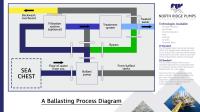 Add My Company
Add My Company
Sign In

Booster Pumps for Seawater and Chlorine Dioxide BWTS System - Case Study
When system pressure is too low on board a vessel, often upgrading or replacing the main seawater pump may seem like the obvious solution, but an alternative way of dealing with low inlet pressures is to utilise a booster pump.
Booster pumps are pumps designed to raise a pressure deemed to be too low within a process. This can be due to a process addition to a system, meaning the added equipment will not function as desired without a higher inlet pressure, or simply due to friction losses being higher than anticipated at design stage, when compared to installation, meaning system modifications are required.
A manufacturer of ballast water treatment systems (BWTS) needed to boost incoming seawater from the main seawater intake pipe/sea chest and handle a mixture of seawater and Chlorine Dioxide (CI02).
What is a Ballast Water Treatment System (BWTS) & How Does it Work?
The International Maritime Organisation (IMO) has specified that ballast water treatment systems (BWTS) require retrofitting on board all vessels by the 8th of September 2024. They have been a requirement on board new builds from the 8th of September 2017. Exemptions are available for vessels sailing between specific domestic ports, with sealed tanks, vessels without ballast tanks and in countries not covered by the Ballast Water Management (BWM) treaty.
BWTS are used to prevent the spreading of organisms. When a vessel loads or offloads cargo at port, ballast is taken onboard in the form of seawater, as a means of stabilising the vessel, ensuring it remains upright, safe, and stable during all stages of a vessels journey.
What occurs is when seawater is taken onboard vessels, microorganisms present within the surrounding water are drawn into ballast tanks or attach themselves to hulls (known as biofouling) which are then inadvertently transported along the vessels journey and later discharged during vessel offloading at port.
This means that non-native or invading species of microorganisms are introduced into other environments which can quickly devastate local ecosystems. Examples of organisms which have spread through ballast water discharge and biofouling include zebra mussels, cheat grass, cholera, comb jelly fish, japanese skeleton shrimp and green crab.
Ballast systems use a variety of technologies from filters with UV light, electrolysis, chemical injection, heat, inert gas, acoustic and magnetic fields to eradicate such microorganisms and prevent their spreading.
There are 2 standards known as D1 & D2 covering water exchange and the level or organisms present within discharges.
What are the D1, and D2 Ballast Water Standards?
D1 & D2 Ballast Water Standards
D1 ballast water exchange standard states that ballast water exchange must occur at least 200 nautical miles from the nearest land and water with at least 95% of the ballast tanks volume exchanged.
D2 ballast water performance standard stipulates the acceptable level or organisms present within a discharged ballast water per cubic meter greater than 50 micrometres in size and per millilitre less than 50 micrometres in size.
There is also a D4 standard which covers prototype technologies with an allowance of up to 5 years to comply with D1 & D2 requirements. Depending on the location of the vessel such as in the US, Antarctic or specific areas mentioned within the IMO Ballast Water Management Convention there can be specific rules which apply.
What is Chlorine Dioxide & Why is it used?
Chlorine dioxide is a very effective disinfectant and biocide used within water treatment applications. It acts as an oxidising agent, causing microorganisms and bacteria which come into contact to weaken, break apart and perish in its presence.
Chlorine dioxide is not only more soluble but is increasingly used in place of chlorine. Its unique structure allows it to absorb up to 5 electrons (as opposed to 2) effectively breaking molecular bonds, by destroying organic molecules, causing the cell or bacteria to perish. It is commonly used in medical and laboratory applications.
This current vessel was undergoing a retrofit of a ballast water treatment system and they needed to increase the current inlet pressure which was insufficient for the system to operate as designed.
This is quite common in retrofitting of equipment such as ballast water treatment, scrubber systems or other equipment required to meet legislation which was not present when the vessel was originally designed.
Our Solution
North Ridge supplied and delivered 2 horizontal centrifugal pumps in polpypropylene which is chemically resistant to both the seawater and levels of dissolved chlorine dioxide present in the water, with 3 phase 60hz motor in under 5 Weeks.
The motor is suitable for operation via VFD meaning the pump flow and booster pressure can be varied as required to meet process requirements.
The casing and impeller are machined from solid polypropylene ensuring the parts are robust, are thicker than other designs and will stand the test of time in a harsh demanding environment.
For more information on Booster Pumps for Seawater and Chlorine Dioxide BWTS System - Case Study talk to North Ridge Pumps Ltd
Enquire Now
List your company on FindTheNeedle.
